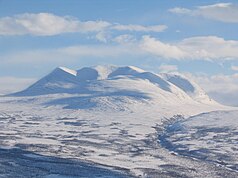Abisko National Park
| Abisko National Park | ||
|---|---|---|
| View of the Abisko National Park | ||
|
|
||
| Location: | Sweden | |
| Next city: | Abisko | |
| Surface: | 77 km² | |
| Founding: | 1909 | |
| The national park in winter | ||
The Abisko National Park ( Swedish : Abisko National Park) is located in the Swedish province of Norrbotten County , in the Swedish- Norwegian border mountains about 200 km north of the Arctic Circle .
The name derives from the nearby near City Abisko from ( Sami : Ábeskovvu = Sea Forest) . As one of the 29 national parks established in Sweden to date , the park was already protected in 1909 and covers an area of 77 km². The highest mountains in the national park are the Slåttatjåhka with 1191 m and the Nuolja with 1169 m.
The national park consists of a valley which is framed by mountain ranges in the south and west and the Torneträsk Lake in the north. This lake is the seventh largest lake in Sweden and the largest in the country in the mountains. The Abiskojokka River, which runs through the entire park, flows through a gorge about 20 m deep just before its mouth. Its steep rock walls give an insight into the geological history of the area
From 1900 there was a small hydroelectric power station on the river. It was built to be able to use electric drills in railway construction. However, the power plant could only be used in summer because the lines froze over in winter.
tourism
One of the most important Swedish long-distance hiking trails, the Kungsleden , begins at the Abisko Turiststation , which can also be reached via the train station of the same name, and leads south through the national park. The largest lakes are the Vuolep Njakajaure , Abiskojaure and Påtjojaure . The European route 10 runs in the section between Kiruna and Narvik parallel to the ore railway (Swedish: Malmbanan), which was completed in 1903, along the banks of the Torneträsk through the national park.
fauna and Flora
The largest mammals found in the park are elk , reindeer, and the occasional predator such as arctic fox , wolverine, and lynx . The smaller ones include squirrels , ermines and mountain lemings . The green warbler is a remarkable breeding bird species .
In the area both come orchids and the Lapland Alpenrose before, as is the White Mountain Avens and various kinds of berries.
The national park is traversed by a river which flows into the Torneträsk Lake via a delta .
In addition to the river, there are also smaller bog plains. The most common tree species in the national park is the dwarf birch . Pine trees are rarely found there.
Aurora borealis
The area has the highest probability of seeing northern lights in the world. There is hardly any light pollution as there are only a few small towns within a radius of about 100 km. Only Kiruna and Narvik have nearly 19,000 inhabitants and are both about an hour away on the European route E10. Abisko is 195 km north of the Arctic Circle, and thus in the middle of the latitude range (60 ° to 80 °), in which the bands of the northern lights mostly occur. In addition, the area has the lowest probability of precipitation in Sweden, as the neighboring mountain Nuolja keeps the clouds out (this corresponds to the translation of its name).
- Aurora borealis near Abisko





